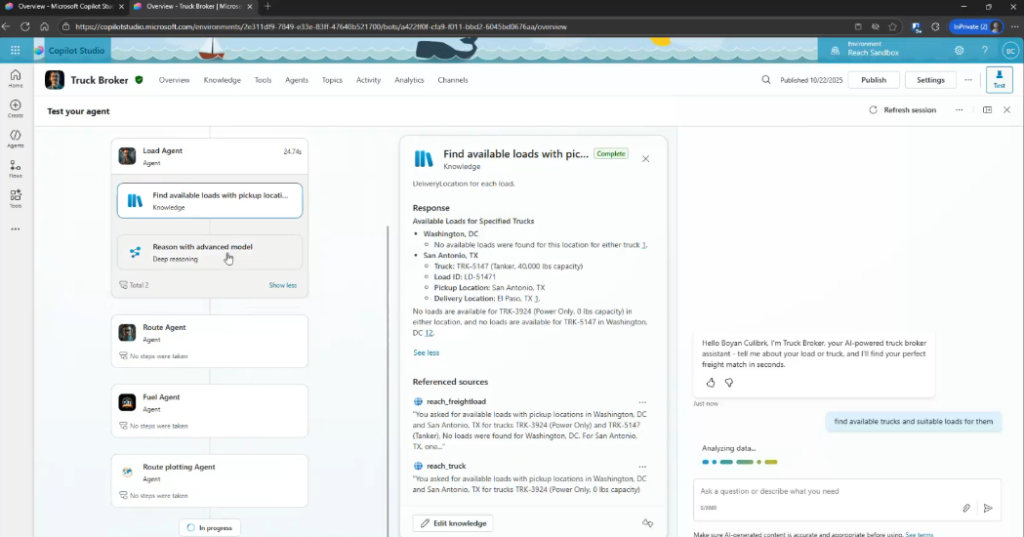If you’ve been following the AI conversation lately, you’ve probably heard the term “agents” thrown around more times than you can count. But here’s the thing: most discussions focus on single agents doing single tasks. What happens when you need multiple specialized agents working together to solve complex, real-world problems?
That’s where multi agent AI systems come in, and that’s exactly what we explored in our recent presentation at Community Summit NA.
The Problem: Truck Brokering Isn’t Simple
Let’s talk about truck brokering for a moment. On the surface, it sounds straightforward: match trucks with loads, optimize routes, make money. Easy, right?
Wrong.
In reality, truck brokering is a symphony of interconnected decisions happening simultaneously:
- Which loads should we accept based on current capacity and profitability?
- Which trucks are available, and where are they located?
- What’s the optimal route considering traffic, fuel costs, and delivery windows?
- How do we handle last-minute changes or cancellations?
- What happens when a truck breaks down mid-route?
Traditional software approaches treat these as separate problems solved by separate systems. You’ve got your TMS (Transportation Management System), your route optimization tool, maybe some basic automation. But these systems don’t really talk to each other in any meaningful way. They certainly don’t collaborate to make intelligent decisions together.

Enter: The Multi Agent AI Systems Approach
What if, instead of building one massive monolithic system trying to handle everything, you created a team of specialized AI agents? Each agent focuses on what it does best, but they all communicate and coordinate to achieve the overall goal.
This isn’t just a theoretical exercise. This is exactly how successful organizations actually work. You don’t have one person doing sales, operations, logistics, and customer service. You have specialists who collaborate.
Multi-agent systems bring this organizational wisdom to AI.
How It Works: Specialized Agents, Unified Goal
In our truck brokering implementation, we designed six specialized agents, each handling a critical piece of the puzzle:
Intake Agent: The gatekeeper. This agent handles truck requirements parsing and validation, ensuring that incoming requests meet the necessary criteria before entering the system.
Load Analysis Agent: Focused on commodity matching and opportunity detection. This agent understands what’s being shipped and identifies the best opportunities based on cargo characteristics.
Matching Agent: The matchmaker of the system. This agent handles carrier-load pairing and profitability ranking, ensuring we’re not just making matches, but making profitable matches.
Geographic Optimization Agent: The route specialist. This agent focuses on route efficiency and delivery window management, making sure trucks take the smartest paths and arrive on time.
Match Scoring Agent: The decision maker. This agent handles final assignment and capacity utilization, ensuring optimal resource allocation across the entire fleet.
Route Analysis Agent: The monitor. This agent provides real-time tracking and performance monitoring, keeping an eye on operations as they unfold.
The beauty of this approach? Each agent can be updated, improved, or replaced independently.
Need better route optimization? Update the geographic optimization agent.
Want to improve profitability calculations? Enhance the matching agent. The system is modular, maintainable, and scalable.

Why This Matters for Your Business
You might be thinking, “Okay, this sounds cool for truck brokering, but what about my industry?”
Here’s the reality: most business problems are multi-faceted coordination challenges. Whether you’re managing:
- Supply chain operations
- Customer service workflows
- Financial planning and analysis
- Healthcare patient coordination
- Manufacturing processes
…you’re dealing with multiple stakeholders, conflicting priorities, and complex decision trees. Multi-agent systems provide a framework for handling this complexity intelligently.
The Technical Sweet Spot
From a technical perspective, multi-agent systems hit a sweet spot between simple automation and full-blown AGI (Artificial General Intelligence).
You’re not trying to build one superintelligent system that knows everything. You’re building specialized, focused agents that are really good at their specific domain. This makes development more manageable, testing more straightforward, and debugging less painful.
Plus, when things go wrong (and they will), it’s much easier to identify which agent made a bad decision rather than trying to debug a black-box monolithic system.
What We Learned
Building this system taught us several critical lessons:
- Agent communication is everything: Your agents are only as good as their ability to share information and coordinate actions.
- Start simple, scale smart: Don’t try to build ten agents on day one. Start with two or three core agents and expand as you understand the patterns.
- Orchestration matters: Someone (or something) needs to be in charge. Decentralized systems sound cool in theory, but most real-world problems need a coordinator.
- Platform choice impacts everything: Whether you build on Copilot Studio, Azure AI Foundry, or another platform fundamentally shapes your architecture and capabilities.
Looking Ahead
Multi-agent systems aren’t just the future – they’re practical today. The technology is mature enough, the platforms are robust enough, and the business cases are compelling enough to start building.
In our next posts, we’ll dive deeper into orchestration patterns, platform comparisons, and the hard-earned lessons from actually implementing these systems in production.
The question isn’t whether multi-agent systems will transform how we build intelligent applications.
Multi-agent systems are already reshaping logistics, manufacturing, and finance.
Connect with Reach to discover how you can apply this architecture to your Microsoft ecosystem.

